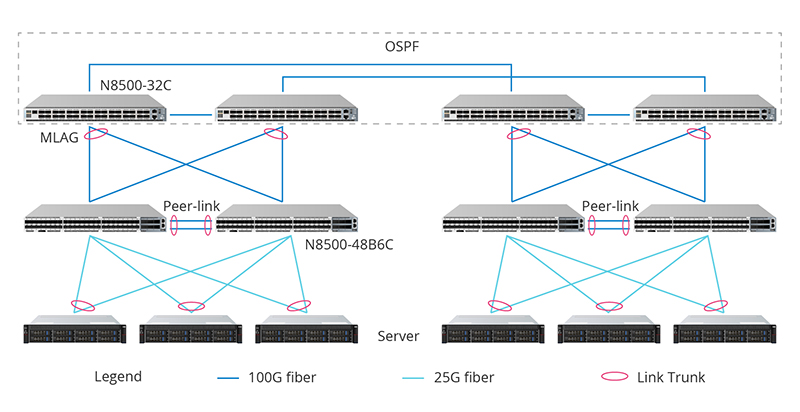100GBASE ER4 Optical Transceiver Overview
Nowadays, the QSFP28 optical transceiver is becoming more and more popular in the market because of its smaller size, lower consumption, and high density. In the previous post, the QSFP28 SR4, QSFP28 LR4, QSFP28 PSM4, and QSFP28 CWDM4 have been described specifically. The transmission distance of those optical transceivers varies from 500m to 10km. But what if you want to transmit for a much longer distance, like 20km, 30km, or even 40km? Now, this post will introduce the module with a 40km transmission distance——100GBASE ER4, from the perspectives of definition, working principle, applications, and FAQs.
What Is the 100Gbase ER4 Standard?
Before you know the definition of the 100G ER4 optical transceiver, I would like to introduce a 100Gbase ER4 standard for you. The 100Gbase ER4 optical module standard is defined by the IEEE 802.3ba which supports the dense wavelength division multiplexing technology to transmit signals by the single-mode fiber optic cables with a working wavelength of 1310nm. The IEEE also defines the ‘ER’ as extended reach. But how does the QSFP28 ER4 extend the transmission distance? The approach to extending the distance is achieved by the use of a Semiconductor Optical Amplifier (SOA) amplifying the light signals before entering the PIN photodetector.
What Is 100GBASE ER4?
The 100G QSFP28 ER4 optical transceiver module is compliant with QSFP MSA, IEEE 802.3ba 100GBASE-ER4 Lite, and OTU4 standard which can reach a distance of 40km on SMF. It supports both 100G Ethernet and OTU4 network applications with a maximum power consumption of 4.5W.
How Does 100G QSFP28 ER4 Work?
The 100G ER4 optical transmitter is operating at the LAN WDM wavelength (1295nm, 1300nm, 1305nm, and 1310nm). The four optical signals from the four wavelengths are multiplexed to transmit on SMF through an industry-standard LC connector (a WDM Mux is used to combine the wavelength signals onto a single fiber). On the receiver side, the SOA amplifies the signals before a WDM Demux splitting the signals into individual channels (the PIN receivers are used to convert the channels back to electrical signals).
Figure 1: QSFP28 ER4 Module Working Principle
100GBASE ER4 Application
The 100G ER4 module is the best choice for long-distance transmission no more than 40km. It can be applied for 100G direct connection and interconnection in enterprise networks and data centers.
Direct Connection Cabling Solution
The QSFP28 ER4 enables 100G direct connection scales all the way up to 40km. Just insert two 100GBASE ER4 modules into the corresponding ports on 100G data center switches, then connect them by LC duplex single-mode patch cables.
Figure 2: QSFP28 ER4 Module Direct Connection
Data Center Interconnect Cabling Solution
The 100G QSFP28 ER4 optical module is suitable for connecting data centers that are sparsely located, which provides a convenient choice for long-distance interconnection between data centers with 100G services. It is an economical solution for high-speed interconnection between distributed data centers. The following diagram shows the basic DCI network solution using 100G QSFP28 ER4 transceivers.
Figure 3: QSFP28 ER4 Module Data Center Interconnection
QSFP28 ER4 FAQs
Q1: What is the difference between QSFP28 ER4 and QSFP28 ER4 Lite Module?
A: The QSFP 100G ER4 has a series of BER requirements of better than 1E-12 without FEC optical modules. However, the receiving sensitivity of 100G QSFP28 ER4 is not satisfied with the existing APD technology. Therefore, many optical module manufacturers/suppliers defined a non-standard 100Gbase ER4 Lite module with a QSFP28 package where the largest transmission distance is up to 40km with FEC or 30km without FEC. FS provides the QSFP28 100G ER4 Lite module compliant with the Ethernet 100Gbase ER4 Lite standard to meet the harshest external operating conditions including temperature, humidity, and EMI interference.
Q2: How does the QSFP 100G ER4 Module differ from the QSFP28 4WDM?
A: The QSFP 100G ER4 optical transceiver supports dual 100G Ethernet applications while the 100G QSFP28 4DWM only supports 100G Ethernet applications. The commons and differences are listed below.
| Form Type | QSFP28 ER4 | QSFP28 4WDM | ||
|---|---|---|---|---|
| Max Data Rate | 25.78125Gbps/27.95Gbps | 25.78125Gbps | ||
| Max Cable Distance | 40km | 10km | 20km | 40km |
| Center Wavelength | 1295.56nm, 1300.05nm, 1304.58nm, 1309.14nm | 1271nm, 1291nm, 1311nm, 1331nm | 1295.56nm, 1300.05nm, 1304.58nm, 1309.14nm | 1295.56nm, 1300.05nm, 1304.58nm, 1309.14nm |
| FEC Requirement | Without FEC (BER 1E-12) | With FEC (BER 5E-5) | ||
| Receiver | SOA+PIN ROSA | PIN ROSA | PIN ROSA | APD ROSA |
| Cooling Requirement | Cooled | Uncooled | Cooled | Cooled |
A: The main difference between 100GBASE ER4 and 100G SR10 is the transmission distance and fiber cables they operate on. The former supports 40km transmission over single-mode fibers through LC connectors, facilitating the development of high-capacity and compact 100G optical equipment used to connect data centers and metro networks. The latter supports link lengths of 100m and 150m respectively on laser-optimized OM3 and OM4 multifiber cables terminated with MPO/MTP-24 connectors. 100G SR10 can also be applied for 10x10 Gigabit Ethernet mode along with ribbon to duplex fiber breakout cables for connectivity from a 100G interface to ten 10G SR optical interfaces.
Related Information
You might be interested in
Email Address

-
PoE vs PoE+ vs PoE++ Switch: How to Choose?
Mar 16, 2023















